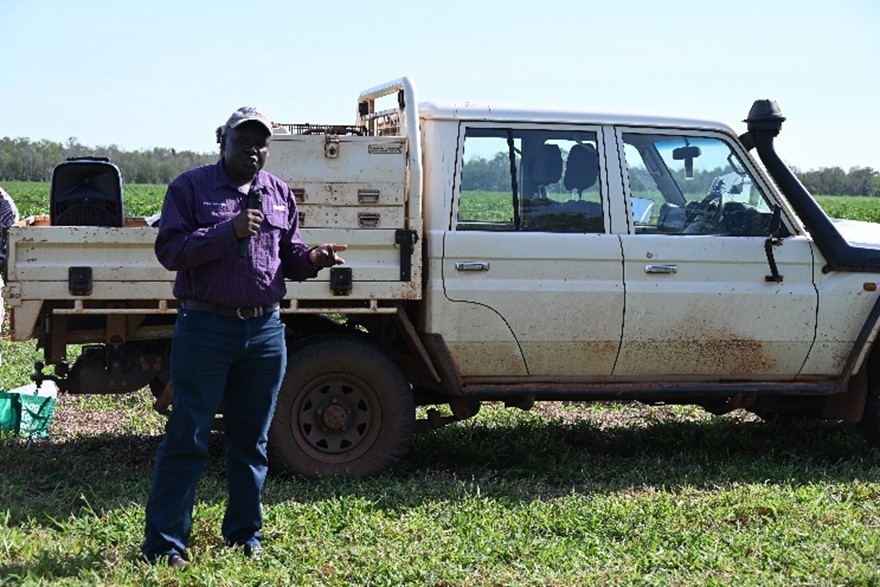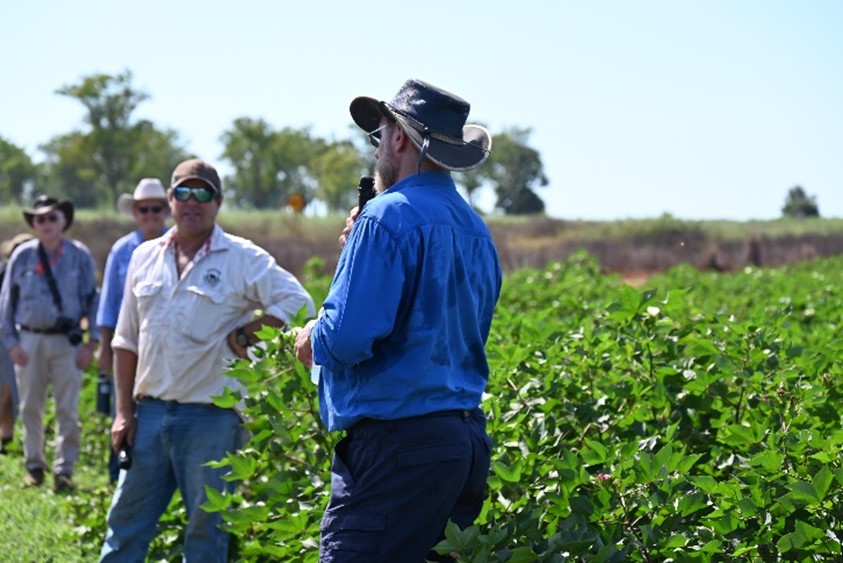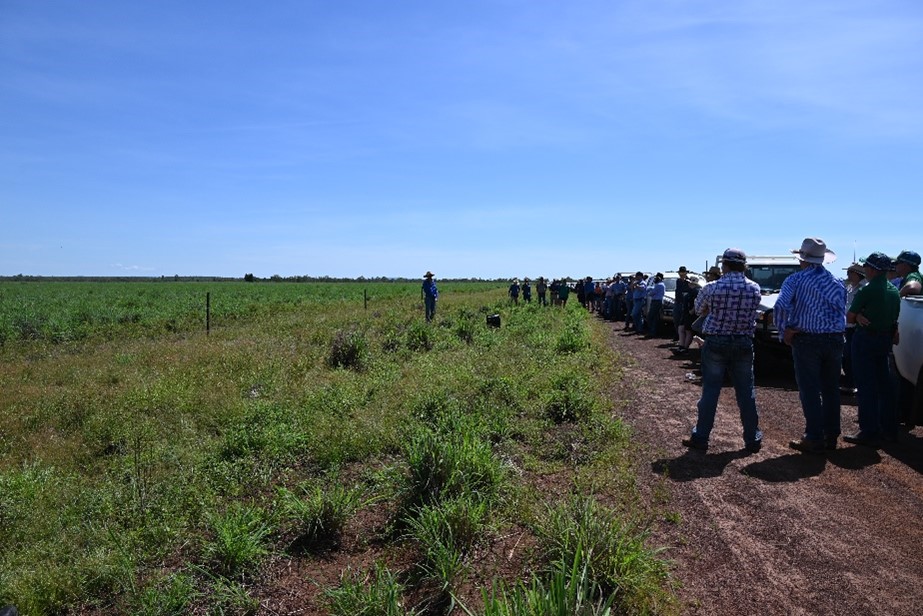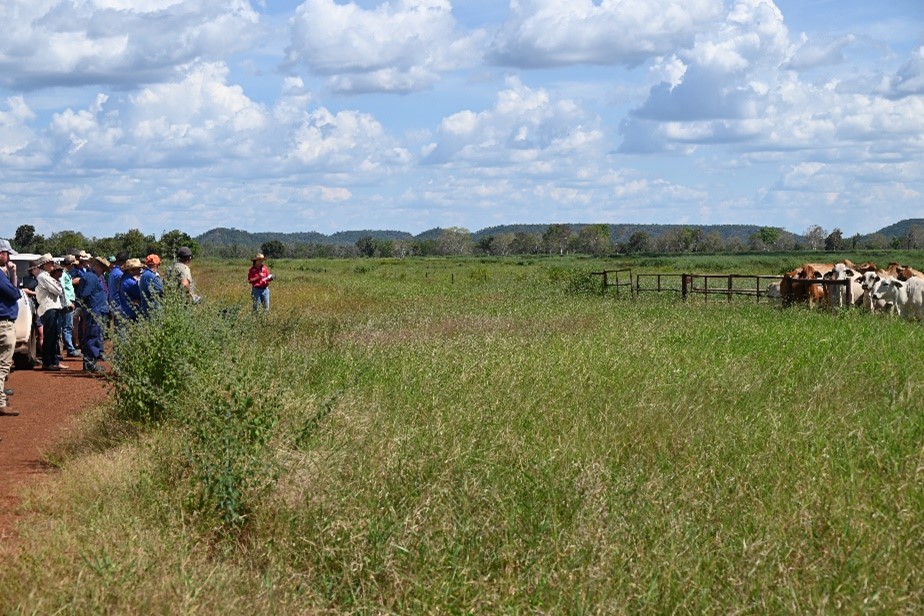Around 55 producers, industry representatives, NTG researchers and extension staff came together on the 4th of April at Douglas Daly Research Farm (DDRF) for a field day centred around sustainability, integration of mixed farming in the northern beef industry, and to hear research updates.
DDRF Field day recap
The day began at the DDRF cotton trials with presentations from Department of Industry, Tourism and Trade (DITT), Cropping Group Leader, Edward Mwando, and Principal Entomologist, Brian Thistleton, and discussions on crop management with DITT’s Nick Hartley and Peter Shotton.
Edward discussed the cotton establishment and rotational trials at Douglas Daly, and also at Katherine Research Station, along with several nearby commercial properties. Trials at DDRF in 3 paddocks involve planting forage as a rotational crops with sequence: cotton – corn; cotton – sorghum; and cotton – cavalcade. A fourth paddock offers continuous cotton planting. These were all planted in January and will be monitored throughout the crop cycle. The aim of these trials are to see what rotational systems work best in this environment, and also investigate the potential of integrating cropping and grazing.
Further trials will be taking place at DDRF to evaluate starter fertiliser placement, timing of nitrogen application, banding vs. top dressing, and splitting nitrogen applications.

Brian Thistleton spoke about the use of integrated pest management (IPM) in the cotton trials at DDRF. Some of the main IPM principles followed for pest control are:
- Only spraying when necessary, to avoid chemical active ingredient resistances and to minimise impact on beneficial bugs.
- Bollguard cotton – Bollguard contains the genes to express toxins to prevent Heliothis, and different species of Spodoptera from eating the cotton bolls. The toxin genes aren’t expressed through the flowers so there may still be some damage to flowers but this is not generally an indication of boll damage.
- Biological control – swamping the environment with artificial female pheromones (disrupted mating) preventing males from finding the females.
- Using a refuge crop such as pigeon pea — the susceptible pests in this population mate with resistant populations in the crop and reduce the number of resistant pests.

The cotton theme continued at local producer Sam McBean’s property where some of the challenges of cotton in the Douglas Daly region were openly discussed. Crop management, plant and soil pathology, and also the introduction of the Cotton myBMP, were key topics.

The group visited the DDRF gamba trial, where gamba grass is being successfully managed by rotational grazing. Gamba grass has spread through an estimated 10,000-15,000 km2 of the northern NT, and where eradication is not possible, the spread must be controlled. Gamba grass is quite palatable in its early growth stages so can be grazed reasonably heavily to prevent it reaching its later growth stages where the risk of spread and the fire hazard are high, and the palatability is low. As well as successfully controlling the height and spread of gamba, rotationally grazing resulted in average daily gains of around 0.65 kg, and up to 0.86 kg in yearling bulls — a significantly higher weight gain than what could have been achieved from the paddock if gamba wasn’t managed rotationally.

Principal Livestock Researcher, Tim Schatz went on to discuss the upcoming project “Crops for Cattle”, a collaboration with the CRCNA that is spread across numerous commercial properties and research stations. It aims to foster the integration of cropping and cattle systems by utilising pre-existing and new grain feeding programs to increase dry season weight gains on NT properties and to quantify the production and economic cost/benefits. Another facet of this project is to investigate the potential for carbon credits. An increased weight gain over the dry season would mean a faster turnover of cattle and less methane produced in the animal’s lifetime.
DITT has collaborated with Y-Tex to investigate the effectiveness of insecticidal ear tags in the Top End. Cattle at DDRF that were given buffalo fly tags had an average weight gain 17kg higher in 25 weeks than cattle that did not have fly tags. DITT is also working with Y-Tex at Beatrice Hill Farm to develop tags with new insecticide agents to combat development of resistance in insect populations.
After lunch, the group pulled up chairs under a shady tree to hear Bron Christensen, CEO of The Leucaena Network, present information and management strategies from leucaena trials, and the benefits and challenges that come with establishment. NT DITT’s Peter Shotton also spoke about the DDRF leucaena trials, which we then drove out to see.

DITT livestock researcher Gretel Bailey-Preston spoke about the DITT Selected Brahman and Composite herds and the journey to increase herd fertility through selection. She also explained the management strategies and use of EBVs (estimated breeding values). DITT breeds around 200 composite and Brahman bulls each year, and after ranking them by their weight, scrotal size, percent normal sperm and dam performance, the top 24 animals with high EBVs in these areas are retained to produce progeny. The rest of the bulls that meet temperament, performance and confrontation criteria are sold in the annual DITT bull sale, to provide the industry with high performing sires that are adapted to NT conditions. Producers were interested in knowing what the breed percentages of the composite cattle were when they started at a set composition in the early 2000’s (56.3% Brahman, 12.5% Africander, 12.5%, Tuli, 6.3% Shorthorn, 6.3% Charolais and 6.3% Hereford) and how they have evolved with selection.

Figure 6: Gretel Bailey-Preston speaking about the cattle in the Repronomics II project targeting fertility by improving the accuracy of EBV’s across Northern cattle herds.

Gretel Bailey-Preston also spoke about the Repronomics II project which is a collaboration with the University of New England’s Animal Genetics and Breeding Unit (AGBU). The project aims to combat low fertility in northern cattle herds through increasing the rate of progress of selection for fertility. This is being done through increasing the accuracy of fertility EBVs, improving our ability to identify the most fertile animals, and developing across breed EBVs. Through testing for the onset of puberty in yearling heifers, and the time to resume cycling after calving, the aim is ultimately to decrease the anoestrous period and potentially increase the number of calves weaned per lifetime. The Repronomics I project (the predecessor to the current project), increased the accuracy of the Days to calving EBV by 18% with the full range of traits the target for the Repronomics II project.
To conclude the day an open discussion moderated by Senior Executive Director of Agriculture, Phil Hausler, provided an open floor for some questions and comments from producers. The questions were able to be answered by relevant industry personnel that were present with expertise in the area. Phil also turned the microphone back to producers to gauge their industry positions and opinions on a number of issues, as future research needs these views to remain relevant and at the forefront of agricultural innovation.

Thank you!
Thank you to all producers, industry representatives and NTG staff for showing their support of the day. Special thanks go to the organisers, speakers, project partners and funding bodies, and drink sponsors Nutrien Ag Solutions.